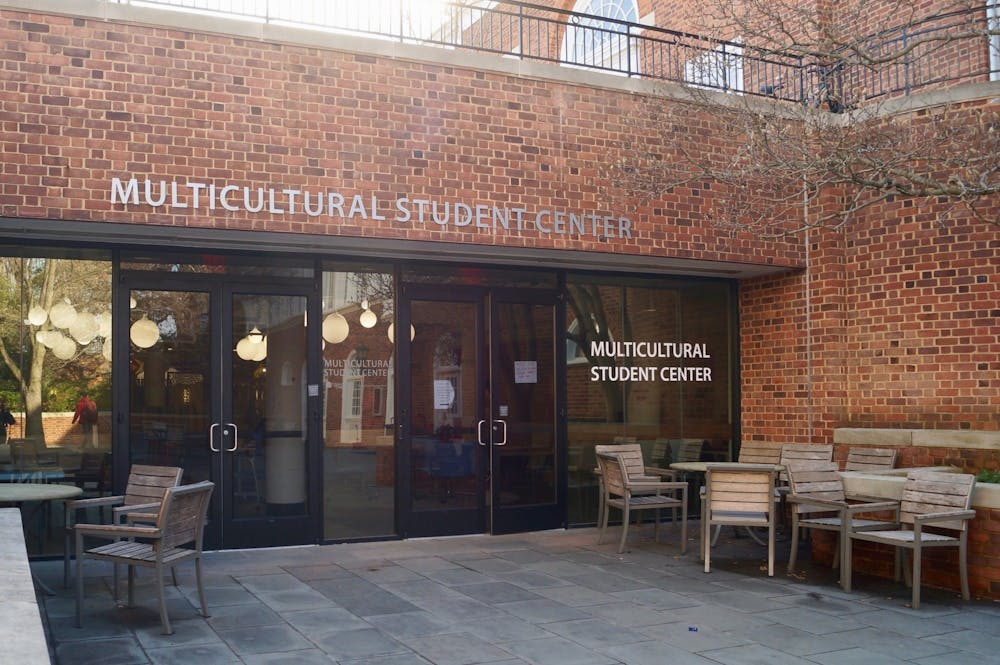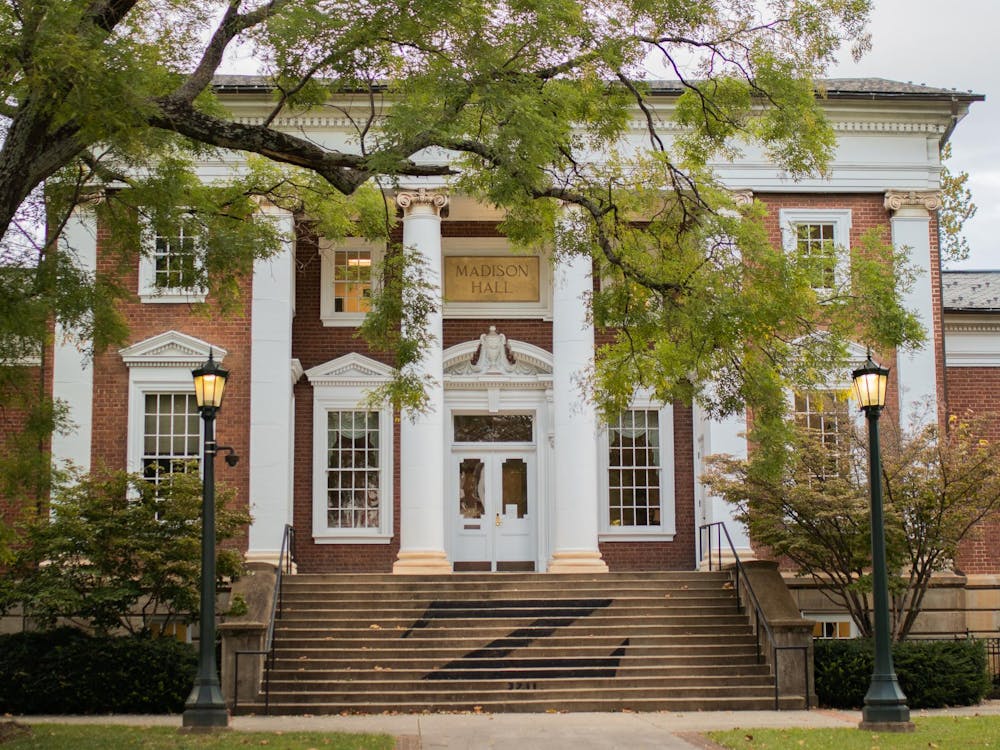Students gathered at the Multicultural Student Center Friday afternoon for a teach-in on the activism of Black and Indigenous students at the University. The event included a tour of places around Grounds that were sites of protest and recognition for Black and Indigenous students, such as the MSC, the Black Bus Stop, the Office of African American Affairs and the Memorial to Enslaved Laborers.
The event began at 1 p.m. with a walking tour of significant locations and concluded at 3 p.m. with a reception and food for attendees, who got to hear about ongoing projects being done by the groups involved in sponsoring the event. The event was a collaboration between History of Enslaved African American Laborers, University Guide Service, Black Student Alliance, Native American Student Union and the Minority Rights Coalition.
The event was coordinated by Kyndall Walker, communication and finance chair of HEAAL and third-year Batten student, who credited the initial idea to Avery Shivers, U-Guides vice-chair and fourth-year College student. It was inspired by the Memory Mondays presentations organized by the Minority Rights Coalition, which are events meant to maintain a collective institutional memory of the University’s minority organizations’ histories.
“We decided that we wanted to have both an Indigenous and Black student activism center-focused,” Walker said. “We were like, okay, how do we create intersectionality with the clubs and organizations? It just flowed so easily because a lot of the tour information was already created from Guides or the respective organizations had this institutional knowledge already. So we just kind of brought it all together to make the tour.”
Members of the University Guides Services gave short presentations at different spots on the tour, each highlighting a particular history or moment of student activism. The first stop on the tour, outside Brooks Hall, is where Native American students, beginning in 2015, held powwow celebrations every year before the COVID-19 pandemic. The tour began with the Native American Student Union’s official acknowledgment the University is built on the “homeland of the Monocan nation, whose members remain a vital part of the local community.”
Zac Russell, co-president of the Native American Student Union and fourth-year College student, spoke of his personal efforts to get the statue of George Rogers Clark, as well as the monument of Sacagewea, Meriweather Lewis and William Clark, removed. He also recounted the experience of seeing the statue before he came to the University, which he referred to as an “idol of genocide.” Russell is a member of the Cherokee Nation and the recipient of the first Native American/Indigenous studies minor.
The George Rogers Clark statue depicted Clark on horseback with an armed crew behind him, as they encroach upon a group of Native Americans. Native American and community activists had denounced the imagery in both depictions as examples of white supremacy and colonial violence for years. The University removed the George Rogers Clark statue and the City removed the Sacajawea statue last summer.
Russell talked about his reaction when he first saw the George Rogers Clark statue.
“I said if I come here, I am not leaving until that statue is gone,” Russell said. “I want Indigenous people to come here to one of the best universities in the country and take that knowledge back to their communities and work for decolonial efforts to make their communities better. This has been our home since time immemorial. And we're here. We're not going anywhere.”
The second stop on the tour highlighted the Memorial for Enslaved Laborers, which was presented by Peyton Hamlett, U-Guide and third-year College student. Before the completion of the memorial, the only recognition of the roughly 4,000 enslaved people who lived and worked at the University was a plaque which recognized the laborers as individuals that “helped to realize Thomas Jefferson’s design for the University of Virginia.” The plaque had been criticized for both its small size and location underneath the entrance to the Rotunda.
Before it was a physical memorial, MEL was a student group with the same name dedicated to the memory of enslaved laborers. In order to garner support for a physical memorialization of enslaved laborers, MEL and other student groups held marches and student forums.
“This space still continues to foster student activism today,” Hamlett said. “It's meant to be a space where students feel safe, especially Black students feel safe gathering because the University of Virginia has always been a place that has been exiling or isolating Black students and not inviting them into the space.”
The group of attendees then walked to East Lawn Room 43 to hear from Alex Martin, U-Guide and third-year Engineering student, and Kurali Grantham, U-Guide and BSA Political Action Committee member and first-year College student, about “trailblazers.” The pair gave the examples of Alice Jackson, Leroy Willis, Gregory Swanson and Robert Bland, all of whom persisted despite institutional discrimination and prejudice against early Black students at the University.
Leroy Willis was the first Black student to be awarded a Lawn room. Alice Jackson was refused admission into a graduate program at the University in 1935 for what the admissions board called “good and sufficient reasons.” Instead, the state paid for her to be educated at Columbia University, where she got her degree in 1937.
In 1950, Gregory Swanson became the first Black person to attend the University and pushed the institution towards desegregation. Robert Bland studied electrical engineering at the University from 1955 to 1959 and became the first African-American student to receive a undergraduate degree from the University.
Two members of the BSA Political Action Committee — second-year College student Leianis Gunn and first-year College student Terrell Pittman — then spoke about the protests that led to the creation of the OAAA in 1976.
The final stop on the tour was the recently-celebrated Black Bus Stop, the UTS bus stop outside Monroe Hall that served as a meeting point and site of gathering for Black students on Grounds from the mid-1970s into the early 2000s. Blakely pointed to the Bus Stop as a form of activism based in joy rather than pain.
“Throughout this tour we have talked about Black and Indigenous student activism as struggle — all the struggles that they've had to go through, all the ways they tried to carve out space for themselves,” Blakely said. “Activism is not about struggle and being sad all the time.. Sometimes activism is about bringing your culture and being loud and proud about it, right? This University should be a space for us all, a space where we don't have to tone down where we're from, to become where we are.
Tatiyanah Blakely, U-Guide and fourth-year College student, reflected on the purpose events like this can serve in educating students about the history of resistance at the institution.
“The problem with student history at U.Va. is a lot of students don't know there is history to ask about,” Blakely said. “I think events like this are so important, just to let people know that there is things they can research and questions they can ask. Because so many of these students are going to take the little bits they learned today and look into it themselves and find even more amazing work that has been done and can be revived or expanded on.”







